Ilankai Tamil Sangam30th Year on the Web Association of Tamils of Sri Lanka in the USA |
|||
 Home Home Archives Archives |
Documenting Atrocities in Darfurby US Dept. of State, September 2004
State Publication 11182 Secretary Powell's opening remarks before the Senate Foreign Relations Committee
Humanitarian Crisis As of August 2004, based on available information, more than 405 villages in Darfur had been completely destroyed, with an additional 123 substantially damaged, since February 2003. Approximately 200,000 persons had sought refuge in eastern Chad as of August, according to the UN High Commissioner for Refugees (UNHCR); the UN Office for the Coordination of Humanitarian Affairs reports another 1.2 million internally displaced persons (IDPs) remain in western Sudan. The total population of Darfur is 6 million. The lack of security in the region continues to threaten displaced persons. Insecurity and heavy rains continue to disrupt humanitarian assistance. The UN World Food Program provided food to nearly 940,000 people in Darfur in July. Nonetheless, since the beginning of the Darfur food program, a total of 82 out of 154 concentrations of IDPs have received food, leaving 72 locations unassisted. Relief and health experts warn that malnutrition and mortality are likely to increase as forcibly displaced and isolated villagers suffer from hunger and infectious diseases that will spread quickly among densely populated and malnourished populations. The health situation for the 200,000 refugees in Chad is ominous. The U.S. Centers for Disease Control and Prevention estimate that one in three children in the refugee settlements in Chad is suffering from acute malnutrition and that crude mortality rates are already well above emergency threshold levels (one per 10,000 per day).
The non-Arab population of Darfur continues to suffer from crimes against humanity. A review of 1,136 interviews shows a consistent pattern of atrocities, suggesting close coordination between GOS forces and Arab militia elements, commonly known as the Jingaweit (Janjaweed). ("Jingaweit" is an Arabic term meaning "horse and gun.")
Ethnographic Background Darfur covers about one-fifth of Sudan’s vast territory and is home to one-seventh of its population. It includes a mixture of Arab and non-Arab ethnic groups, both of which are predominantly Muslim (see map, p. 6). The Fur ethnic group (Darfur means "homeland of the Fur") is the largest non-Arab ethnic group in the region. Northern Darfur State is home to the nomadic non-Arab Zaghawa but also includes a significant number of Arabs, such as the Meidab. Sedentary non-Arabs from the Fur, Massalit, Daju, and other ethnic groups live in Western Darfur State. The arid climate and the competition for scarce resources over the years have contributed to recurring conflict between nomadic Arab herders and non-Arab farmers, particularly over land and grazing rights. Various ethnic groups have fought over access to water, grazing rights, and prized agricultural land as desertification has driven herders farther south. Political and Military Conflict Ethnic violence affected the Darfur region in the 1980s. In 1986, Prime Minister Sadiq al-Mahdi armed the ethnic-Arab tribes to fight John Garang’s Sudanese People’s Liberation Army (SPLA). After helping the GOS beat back an SPLA attack in Darfur in 1991, one of these Arab tribes sought to resolve ancient disputes over land and water rights by attacking the Zaghawa, Fur, and Massalit peoples. Arab groups launched a campaign in Southern Darfur State that resulted in the destruction of some 600 non-Arabvillages and the deaths of about 3,000 people.The GOS itself encouraged the formation of an "Arab Alliance" in Darfur to keep non-Arab ethnic groups in check. Weapons flowed into Darfur and the conflict spread. After President Bashir seized power in 1989, the new government disarmed non-Arab ethnic groups but allowed politically loyal Arab allies to keep their weapons.
The GOS has provided support to Arab militiamen attacking non-Arab civilians, according to press and NGO reports. Refugee accounts corroborated by US and other independent reporting suggest that Khartoum has continued to provide direct support for advancing Jingaweit. Aerial bombardment and attacks on civilians reportedly have occurred widely throughout the region; respondents named more than 100 locations that experienced such bombardment (see map, p. 8). The extent to which insurgent base camps were co-located with villages and civilians is unknown. The number of casualties caused by aerial bombardment cannot be determined, but large numbers of Darfurians have been forced to flee their villages. According to press and NGO reports, the GOS has given Jingaweit recruits salaries, communication equipment, arms, and identity cards. Current International Response On July 30, 2004, the UN Security Council adopted Resolution 1556, which demanded that the GOS fulfill commitments it made to disarm the Jingaweit militias and apprehend and bring to justice Jingaweit leaders and their associates; it also called on the GOS to allow humanitarian access to Darfur, among other things. The UN placed an embargo on the sale or supply of materiel and training to non-governmental entities and individuals in Darfur. The resolution endorsed the African Union deployment of monitors and a protection force to Darfur. It requested the Secretary-General to report on GOS progress in 30 days and held out the possibility of further actions, including sanctions, against the GOS in the event of non-compliance. The Security Council has expressed its deep concern over reports of large-scale violations of human rights and international humanitarian law in Darfur. The main protection concerns identified by the UN Relief agencies’ access to areas outside the state capitals of Al Junaynah, Al Fashir, and Nyala was limited until late May. Visits by UN Secretary-General Annan and Secretary of State Powell in June 2004 brought heightened attention to the growing humanitarian crisis. As a result, the GOS lifted travel restrictions and announced measures to facilitate humanitarian access. Nonetheless, serious problems remain, specifically capacity, logistics, and security for relief efforts. USAID’s Disaster Assistance Response Team and other agencies have deployed additional staff to increase emergency response capacity. Refugee Interviews--Survey Results The Atrocities Documentation Team conducted a random-sample survey of Darfurian refugees in eastern Chad in July and August 2004. The team interviewed 1,136 refugees, many of whom had endured harsh journeys across the desolate Chad-Sudan border. A plurality of the respondents were ethnic Zaghawa (46 percent), with smaller numbers belonging to the Fur (8 percent) and Massalit (30 percent) ethnic groups. Slightly more than half the respondents (56 percent) were women. (See map, p. 6, showing ethnicity of respondent refugees.)
Most reports followed a similar pattern: When describing attacks, refugees often referred to GOS soldiers and Jingaweit militias as a unified group; as one refugee stated, "The soldiers and Jingaweit, always they are together." The primary victims have been non-Arab residents of Darfur. Numerous credible reports corroborate the use of racial and ethnic epithets by both the Jingaweit and GOS military personnel; "Kill the slaves; Kill the slaves!" and "We have orders to kill all the blacks" are common. One refugee reported a militia member stating, "We kill all blacks and even kill our cattle when they have black calves." Numerous refugee accounts point to mass abductions, including persons driven away in GOS vehicles, but respondents usually do not know the abductees’ fate. A few respondents indicated personal knowledge of mass executions and gravesites.
Respondents reported ethnic tensions in the region had risen over the past few years. For example, markets in which non-Arabs and Arabs had previously interacted have become segregated, and almost all villages are now said to be ethnically homogenous. According to many of the interviewees, GOS soldiers and Jingaweit attacked villages because of their non-Arab populations; men of fighting age have been abducted, executed, or both; and women and girls have been abducted and raped. Refugee Interviews--Survey Methodology Refugees were selected using a systematic, random sampling approach designed to meet the conditions in Chad. Interviewers randomly selected a sector within a refugee camp and then, from a fixed point within the sector, chose every 10th dwelling unit for interviewing. All adults were listed within the dwelling unit, and one adult was randomly selected. This methodology ensures the results are as representative as possible in light of refugee conditions. Interviews took place in private, with only the refugee, a translator, and the interviewer present.
The field data for the 1,136 interviews were compiled using a standardized data entry process that involved the collection and coding of detailed information from each refugee respondent’s set of answers. The researchers then used a statistical program to aggregate the data and analyze the results.
|
||
|
|||
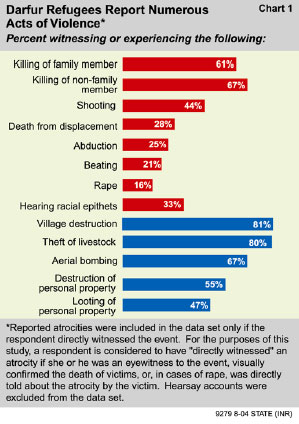 An Atrocities Documentation Team, assembled at the initiative of the US Department of State’s Bureau of Democracy, Human Rights and Labor (DRL), conducted interviews in Chad in July and August. The team was primarily composed of independent experts recruited by the Coalition for International Justice (CIJ), and also included experts from the American Bar Association (ABA), DRL, and the State Department’s Bureau of Intelligence and Research (INR) as well as the US Agency for International Development (USAID). INR was responsible for compiling the survey data and producing the final report. USAID met the costs of the CIJ and ABA.
An Atrocities Documentation Team, assembled at the initiative of the US Department of State’s Bureau of Democracy, Human Rights and Labor (DRL), conducted interviews in Chad in July and August. The team was primarily composed of independent experts recruited by the Coalition for International Justice (CIJ), and also included experts from the American Bar Association (ABA), DRL, and the State Department’s Bureau of Intelligence and Research (INR) as well as the US Agency for International Development (USAID). INR was responsible for compiling the survey data and producing the final report. USAID met the costs of the CIJ and ABA. 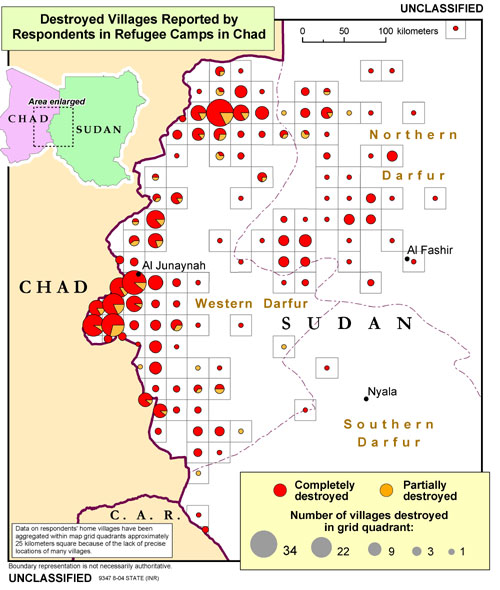 Human Rights Crisis
Human Rights Crisis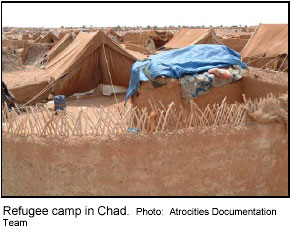 The UN estimates the violence has affected 2.2 million of Darfur’s 6 million residents. The GOS claims it has been unable to prevent Jingaweit atrocities and that the international community has exaggerated the extent and nature of the crisis. The GOS has improved international relief access to IDPs in Darfur since July, but problems, including lack of security and seasonal rains, have hampered relief programs. Survey results indicate that most Sudanese refugees state that Jingaweit militias and GOS military forces collaborate in carrying out systematic attacks against non-Arab villages in Darfur.
The UN estimates the violence has affected 2.2 million of Darfur’s 6 million residents. The GOS claims it has been unable to prevent Jingaweit atrocities and that the international community has exaggerated the extent and nature of the crisis. The GOS has improved international relief access to IDPs in Darfur since July, but problems, including lack of security and seasonal rains, have hampered relief programs. Survey results indicate that most Sudanese refugees state that Jingaweit militias and GOS military forces collaborate in carrying out systematic attacks against non-Arab villages in Darfur. 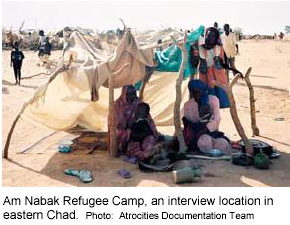 In February 2003, rebels calling themselves the Darfur Liberation Front (DLF) attacked GOS military installations and the provincial capital of Al Fashir. The DLF complained of economic marginalization and demanded a power sharing arrangement with the GOS. In March 2003, the DLF changed its name to the Sudan Liberation Movement/Army (SLM/A), intensified its military operations, unveiled a political program for a "united democratic Sudan," and bolstered its strength to some 4,000 rebels. The Justice and Equality Movement, with fewer than 1,000 rebels, was established in 2002 but has since joined the SLM/A in several campaigns against GOS forces.
In February 2003, rebels calling themselves the Darfur Liberation Front (DLF) attacked GOS military installations and the provincial capital of Al Fashir. The DLF complained of economic marginalization and demanded a power sharing arrangement with the GOS. In March 2003, the DLF changed its name to the Sudan Liberation Movement/Army (SLM/A), intensified its military operations, unveiled a political program for a "united democratic Sudan," and bolstered its strength to some 4,000 rebels. The Justice and Equality Movement, with fewer than 1,000 rebels, was established in 2002 but has since joined the SLM/A in several campaigns against GOS forces.  and corroborated by the Atrocities Documentation Team include threats to life and freedom of movement, forced relocation, forced return, sexual violence, and restricted access to humanitarian assistance, social services, sources of livelihood, and basic services. Food security has been precarious and will probably worsen as the rainy season continues. Many displaced households no longer can feed themselves because of the loss of livestock and the razing of food stores.
and corroborated by the Atrocities Documentation Team include threats to life and freedom of movement, forced relocation, forced return, sexual violence, and restricted access to humanitarian assistance, social services, sources of livelihood, and basic services. Food security has been precarious and will probably worsen as the rainy season continues. Many displaced households no longer can feed themselves because of the loss of livestock and the razing of food stores.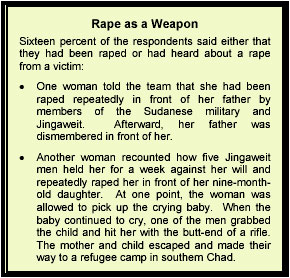 Analysis of the refugee interviews points to a pattern of abuse against members of Darfur’s non-Arab communities, including murder, rape, beatings, ethnic humiliation, and destruction of property and basic necessities. Many of the reports detailing attacks on villages refer to government and militia forces, preceded by aerial bombardment, acting together to commit atrocities. Respondents said government and militia forces wore khaki or brown military uniforms. Roughly one-half of the respondents noted GOS forces had joined Jingaweit irregulars in attacking their villages. Approximately one-quarter of the respondents said GOS forces had acted alone; another 14 percent said the Jingaweit had acted alone. Two-thirds of the respondents reported aerial bombings against their villages; four-fifths said they had witnessed the complete destruction of their villages. Sixty-one percent reported witnessing the killing of a family member. About one-third of the respondents reported hearing racial epithets while under attack; one-quarter witnessed beatings. Large numbers reported the looting of personal property (47 percent) and the theft of livestock (80 percent).
Analysis of the refugee interviews points to a pattern of abuse against members of Darfur’s non-Arab communities, including murder, rape, beatings, ethnic humiliation, and destruction of property and basic necessities. Many of the reports detailing attacks on villages refer to government and militia forces, preceded by aerial bombardment, acting together to commit atrocities. Respondents said government and militia forces wore khaki or brown military uniforms. Roughly one-half of the respondents noted GOS forces had joined Jingaweit irregulars in attacking their villages. Approximately one-quarter of the respondents said GOS forces had acted alone; another 14 percent said the Jingaweit had acted alone. Two-thirds of the respondents reported aerial bombings against their villages; four-fifths said they had witnessed the complete destruction of their villages. Sixty-one percent reported witnessing the killing of a family member. About one-third of the respondents reported hearing racial epithets while under attack; one-quarter witnessed beatings. Large numbers reported the looting of personal property (47 percent) and the theft of livestock (80 percent). 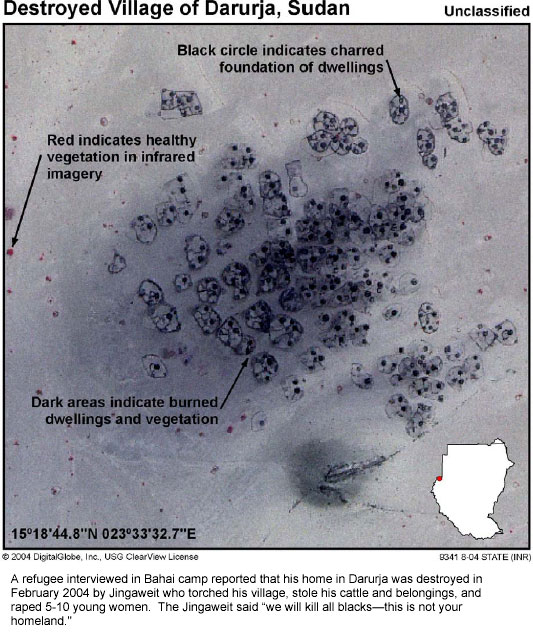 A subset of 400 respondents were asked about rebel activity in or near their villages. Nearly nine in 10 said there was no rebel activity before the attack. Nine percent noted rebels were in the vicinity; 2 percent said the rebels were present in their villages. The overwhelming majority (91 percent) said their village was not defended at all against the attack. One percent asserted their village had been successfully defended and another 8 percent cited an unsuccessful defense.
A subset of 400 respondents were asked about rebel activity in or near their villages. Nearly nine in 10 said there was no rebel activity before the attack. Nine percent noted rebels were in the vicinity; 2 percent said the rebels were present in their villages. The overwhelming majority (91 percent) said their village was not defended at all against the attack. One percent asserted their village had been successfully defended and another 8 percent cited an unsuccessful defense. 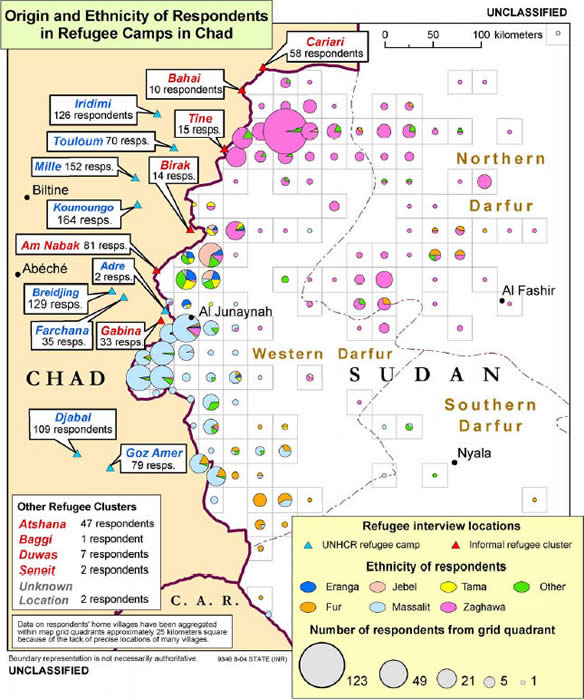 Several characteristics of the survey must be underscored. First, accounts of atrocities may be dated, depending on when the individual refugee fled his or her village. Second, the data may actually undercount the extent of atrocities because mass attacks often leave few survivors. Third, most
Several characteristics of the survey must be underscored. First, accounts of atrocities may be dated, depending on when the individual refugee fled his or her village. Second, the data may actually undercount the extent of atrocities because mass attacks often leave few survivors. Third, most 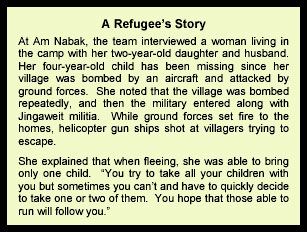 respondents come from villages within 50 miles of the border in Western Darfur and Northern Darfur States. Fourth, it is very likely that rapes are underreported because of the social stigma attached to acknowledging such violations of female members of one’s family.
respondents come from villages within 50 miles of the border in Western Darfur and Northern Darfur States. Fourth, it is very likely that rapes are underreported because of the social stigma attached to acknowledging such violations of female members of one’s family. 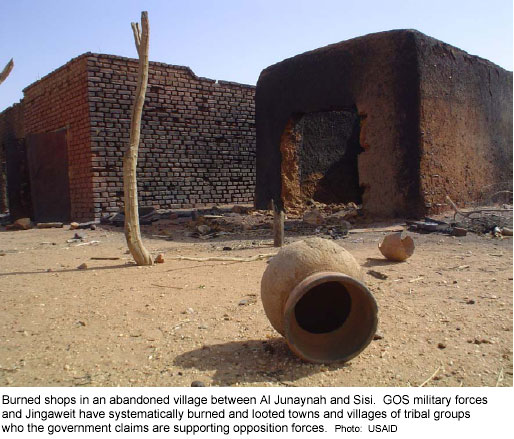 representative a sample as was feasible under the prevailing conditions. Dates of events reported by refugees frequently utilized the Islamic calendar; these dates were then converted to dates on the Gregorian calendar. (See map, p. 6, showing interview locations.)
representative a sample as was feasible under the prevailing conditions. Dates of events reported by refugees frequently utilized the Islamic calendar; these dates were then converted to dates on the Gregorian calendar. (See map, p. 6, showing interview locations.)